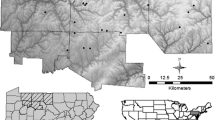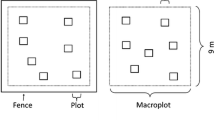Abstract
Forest fragmentation may benefit generalist herbivores by increasing access to various substitutable food resources, with potential consequences for their population dynamics. We studied a European roe deer (Capreolus capreolus) population living in an agricultural mosaic of forest, woodlots, meadows and cultivated crops. We tested whether diet composition and quality varied spatially across the landscape using botanical analyses of rumen contents and chemical analyses of the plants consumed in relation to landscape metrics. In summer and non-mast winters, roe deer ate more cultivated seeds and less native forest browse with increasing availability of crops in the local landscape. This spatial variation resulted in contrasting diet quality, with more cell content and lower lignin and hemicellulose content (high quality) for individuals living in more open habitats. The pattern was less marked in the other seasons when diet composition, but not diet quality, was only weakly related to landscape structure. In mast autumns and winters, the consumption of acorns across the entire landscape resulted in a low level of differentiation in diet composition and quality. Our results reflect the ability of generalist species, such as roe deer, to adapt to the fragmentation of their forest habitat by exhibiting a plastic feeding behavior, enabling them to use supplementary resources available in the agricultural matrix. This flexibility confers nutritional advantages to individuals with access to cultivated fields when their native food resources are depleted or decline in quality (e.g. during non-mast years) and may explain local heterogeneities in individual phenotypic quality.





Similar content being viewed by others
References
Abrahamson WG, Layne NJ (2003) Long-term patterns of acorn production for five oak species in xeric Florida uplands. Ecology 84:2476–2492
Andersen R, Duncan P, Linnell JDC (1998) The European roe deer the biology of success. Scandinavian University Press, Oslo
Andren H (1994) Effects of habitat fragmentation on birds and mammals in landscapes with different proportions of suitable habitat—a review. Oikos 71:355–366
Barancekova M (2004) The roe deer diet: is floodplain forest optimal habitat. Folia Zool 53:285–292
Benhaiem S, Delon M, Lourtet B, Cargnelutti B, Aulagnier S, Hewison AJM, Morellet N (2008) Hunting increases vigilance levels in roe deer and modifies feeding site selection. Anim Behav 76:611–618
Bohn U, Gullub G, Hettwer C, Neuhäuslova Z, Schlüter H, Weber H (2004) Map of the natural vegetation of Europe. Scale 1:2,500,000. Interactive CD ROM (S. Hennekens). Federal Agency for Nature Conservation, Germany
Brinkman TJ, Jenks JA, DePerno CS, Haroldson BS, Osborn RG (2004) Survival of white-tailed deer in an intensively farmed region of Minnesota. Wildl Soc Bull 32:726–731
Brown R, Hellgren EC, Abbott M, Ruthven DC, Bingham RL (1995) Effects of dietary energy and protein restriction on nutritional indices of female white-tailed deer. J Wildl Manag 59:595–609
Cargnelutti B (2007) Influence de l’hétérogénéité du paysage sur l’occupation de l’espace de chevreuils (Capreolus capreolus) vivant en milieu fragmenté. Mémoire Ecole Pratique des Hautes Etudes. Université Montpellier 2, Montpellier
Cargnelutti B, Reby D, Desneux L, Angibault J-M, Joachim J, Hewison AJM (2002) Space use by roe deer in a fragmented landscape some preliminary results. Rev Ecol (Terre Vie) 57:29–37
Cornelis J, Casaer J, Hermy M (1999) Impact of season, habitat and research techniques on diet composition of roe deer Capreolus capreolus a review. J Zool Lond 248:195–207
Danilkin A, Hewison AJM (1996) Behavioural ecology of Siberian and European roe deer. Chapman and Hall, London
Devictor V, Julliard R, Jiguet F (2008) Distribution of specialist and generalist species along spatial gradients of habitat disturbance and fragmentation. Oikos 117:507–514. doi:10.1111/j.2008.0030-1299.16215.x
Dolédec S, Chessel D (1991) Recent developments in linear ordination methods for environmental sciences. Adv Ecol 1:133–155
Dray S, Chessel D, Thioulouse J (2003) Co-inertia analysis and the linking of the ecological data tables. Ecology 84:3078–3089
Feldhamer GA (2001) Acorns and white-tailed deer—interrelationships in forest ecosystems. In: McShea WM, Healy WM (eds) Oak forest ecosystems: ecology and management for wildlife. Johns Hopkins University Press, Baltimore, pp 215–223
Gascon C, Thomas E, Richard O, Bierregaard JR, Malcom JR, Stouffer PC, Vasconcelos HL, Laurance WF, Zimmerman B, Tocher M, Borges S (1999) Matrix habitat and species richness in tropical forest remnants. Biol Conserv 91:223–229
Giger S, Pochet S (1987) Méthodes d’estimation des constituants pariétaux dans les aliments destinés aux ruminants. Bull Tech CRZV 70:49–60
Gill R (1990) Monitoring the status of European and North American cervids, Global Environment Monitoring System (G E M S) Information series 8, UNEP, Nairobi
Godvik IMR, Loe LE, Vik JO, Veiberg V, Langvatn R, Mysterud A (2009) Temporal scales, trade-offs and functional responses in habitat selection of red deer. Ecology 90:699–710
Hewison AJM, Vincent JP, Reby D (1998) Social Organisation of European roe deer. In: Andersen R, Duncan P, Linnell JDC (eds) The European roe deer: the biology of success. Scandinavian University Press, Oslo, pp 189–219
Hewison AJM, Angibault J-M, Cargnelutti B, Coulon A, Rames J-L, Serrano E, Verheyden H, Morellet N (2007) Using radio-tracking and direct observation to estimate roe deer Capreolus capreolus density in a fragmented landscape: a pilot study. Wildl Biol 13:313–318
Hewison AJM, Morellet N, Verheyden H, Daufresne T, Angibault J-M, Cargnelutti B, Merlet J, Picot D, Rames J-L, Joachim J, Lourtet B, Serrano E, Bideau E, Cebe N (2009) Landscape fragmentation influences winter body mass of roe deer. Ecography 32:1062–1070
Jarnemo A (2002) Roe deer Capreolus capreolus fawns and mowing—mortality rates and counter measures. Wildl Biol 8:211–218
Jepsen JU, Topping CJ (2004) Modelling roe deer (Capreolus capreolus) in a gradient of forest fragmentation: behavioural plasticity and choice of cover. Can J Zool 82:1528–1541. doi:10.1139/z04-131
Kjellander P, Gaillard J-M, Hewison AJM (2006) Density dependent responses of fawn cohort body mass in two contrasting roe deer populations. Oecologia 146:521–530. doi:10.1007/s00442-005-0188-z
Kupfer JA, Malanson GP, Franklin SB (2006) Not seeing the ocean for the islands: the mediating influence of matrix-based processes on forest fragmentation effects. Glob Ecol Biogeogr 15:8–20
Lamberti P, Mauri L, Merli E, Dusi S, Apollonio M (2006) Use of space and habitat selection by roe deer Capreolus capreolus in a Mediterranean coastal area: how does woods landscape affect home range? J Ethol 24:181–188. doi:10.1007/s10164-005-0179-x
Lovari S, San José C (1997) Wood dispersion affects home range size of female roe deer. Behav Process 40:239–241
Maizeret C, Tran Manh Sung D (1984) Etude du régime alimentaire et recherche du déterminisme fonctionnel de la sélectivité chez le Chevreuil (Capreolus capreolus) des Landes de Gascogne. Gibier Faune Sauvage 3:63–103
McLoughlin PD, Gaillard J-M, Boyce MS, Bonenfant C, Messier F, Duncan P, Delorme D, Van Moorter B, Said S, Klein F (2007) Lifetime reproductive success and composition of the home range in a large herbivore. Ecology 88:3192–3201
McShea WJ, Schwede G (1993) Variable acorn crops: responses of white-tailed deer and other mast consumers. J Mammal 74:999–1006
Miyashita T, Suzuki M, Ando D, Fujita G, Ochiai K, Asada M (2008) Forest edge creates small-scale variation in reproductive rate of sika deer. Popul Ecol 50:111–120. doi:10.1007/s10144-0068-y
Morellet N, Van Moorter B, Cargnelutti B, Angibault J-M, Lourtet B, Merlet J, Ladet S, Hewison AJM (2011) Landscape composition influences roe deer habitat selection at both home range and landscape scales. Landscape Ecol (in press)
Nilsen EB, Linnell JDC, Andersen R (2004) Individual access to preferred habitat affects fitness components in female roe deer Capreolus capreolus. J Anim Ecol 73:44–50
Panzacchi M, Linnell JDC, Odden M, Odden J, Andersen R (2009) Habitat and roe deer fawn vulnerability to red fox predation. J Anim Ecol 78:1124–1133
Peter D, Smallwood WM, David P (1986) Grey squirrel food preferences: the effects of tannin and fat concentration. Ecology 67:168–174
Pettorelli N, Dray S, Gaillard J-M, Chessel D, Duncan P, Illius A, Guillon N, Klein F, Van Laere G (2003a) Spatial variation in springtime food resources influences the winter body mass of roe deer fawns. Oecologia 137:363–369. doi:10.1007/s00442-003-1364-7
Pettorelli N, Gaillard J-M, Duncan P, Maillard D, Van Laere G, Delorme D (2003b) Age and density modify the effects of habitat quality on survival and movements of roe deer. Ecology 84:3307–3316
Pettorelli N, Gaillard J-M, Yoccoz NG, Duncan P, Maillard D, Delorme D, Van Laere G, Toigo C (2005) The response of fawn survival to changes in habitat quality varies according to cohort quality and spatial scale. J Anim Ecol 74:972–981. doi:10.1111/j.1365-2656.2005.00988.x
Picard JF, Oleffe P, Boisaubert B (1991) Influence of oak mast on feeding behaviour of red deer (Cervus elaphus L). Ann Sci For 48:547–559
Putman RJ (1997) Deer and road traffic accidents: options for management. J Environ Manag 51:43–57
Putman RJ, Moore NP (1998) Impact of deer in lowland Britain on agriculture, forestry and conservation habitats. Mammal Rev 28:141–164
R Development Core Team (2009) R: a language and environment for statistical computing. R Foundation for Statistical Computing, Vienna
Robbins CT (1993) Wildlife feeding and nutrition. Academic, London
Robinson RA, Sutherland WJ (2002) Post-war changes in arable farming and biodiversity in Great Britain. J Appl Ecol 39:157–176
Said S, Gaillard J-M, Widmer O, Debias F, Bourgoin G, Delorme D, Roux C (2009) What shapes intra-specific variation in home range size? A case study of female roe deer. Oikos 118:1299–1306. doi:10.1111/j.1600-0706.2009.17346.x
San José C, Lovari S, Ferrari N (1997) Grouping in roe deer: an effect of habitat openness or cover distribution. Acta Theriol 42:235–239
Seagle SW, Frostburg R (2003) Can ungulates foraging in a mutiple-use landscape alter forest nitrogen budgets? Oikos 103:230–234
Silva M, Hartling L, Opps SB (2005) Small mammals in agricultural landscapes of Prince Edward Island (Canada): effects of habitat characteristics at three different spatial scales. Biol Conserv 126:556–568
Sotherton NW (1998) Land use changes and the decline of farmland wildlife an appraisal of the set-aside approach. Biol Conserv 83:259–268
Tixier H, Duncan P (1996) Are European roe deer browsers? A review of variations in the composition of their diets. Rev Ecol (Terre Vie) 51:3–17
Tufto J, Andersen R, Linnell JDC (1996) Habitat use and ecological correlates of home range size in a small cervid: the roe deer. J Anim 65:715–724
Van Soest PJ, Robertson JB, Lewis BA (1991) Methods for dietary fiber, neutral detergent fiber, and non starch polysaccharides in relation to animal nutrition. J Dairy Sci 74:3583–3597
Walter WD, Leslie DM, Hellgren EC, Engle DM (2010) Identification of subpopulations of North American elk (Cervus elaphus L.) using multiple lines of evidence: habitat use, dietary choice, and fecal stable isotopes. Ecol Res 25:789–800. doi:10.1007/s11284-010-0709-z
Weerasinghe UR, Takatsuki S (1999) A record of acorn eating by sika deer in western Japan. Ecol Res 14:205–209
Acknowledgments
We thank the Syrian Ministry of Higher Education and the French Ministry of Foreign Affairs for the award of a PhD grant to Frial Abbas. We would like to thank J.P. Chanal and the local hunting associations, as well as the Fédération Départementale des Chasseurs de la Haute Garonne, for permission to collect rumen samples. We thank Emmanuel Serrano for assistance with collecting rumen samples. We are grateful to Carole Bannelier and Patrick Petibon for assistance in chemical analysis. We thank numerous colleagues and students for their help collecting plant samples. We thank two referees and Jean-Michel Gaillard for helpful and constructive comments on a previous version of the manuscript.
Author information
Authors and Affiliations
Corresponding author
Additional information
Communicated by Jean-Michel Gaillard.
Electronic supplementary material
Below is the link to the electronic supplementary material.
Rights and permissions
About this article
Cite this article
Abbas, F., Morellet, N., Hewison, A.J.M. et al. Landscape fragmentation generates spatial variation of diet composition and quality in a generalist herbivore. Oecologia 167, 401–411 (2011). https://doi.org/10.1007/s00442-011-1994-0
Received:
Accepted:
Published:
Issue Date:
DOI: https://doi.org/10.1007/s00442-011-1994-0




